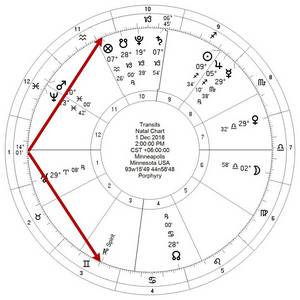This post is an experiment.
Some things are more easily explained in a video, by showing and talking about them, then by a blog post. I want to try combining the two here.
I just posted a video that I titled, Midpoints and Traditional Astrology.
Here I want to briefly summarize the main points I make in the video.
—
Midpoints are not mentioned by name as such in traditional texts. But, the logic and geometry of some early traditional techniques is the same as the logic of Midpoints, and implies their use.
Examples are:
Lots, which created a geometric shape called an isosceles trapezoid (a triangle with the top cut off). That structure always has two pairs of points that share a common midpoint, and hence a common midpoint axis between them.
Antiscia (and Contra-Antiscia), which are basically a set of shared midpoints across an axis. Antiscia are midpoints across the Cancer/Capricorn axis, Contra-Antiscia across the Aries/Libra axis.
—
Midpoints and axes or angles go together.
When you have shared midpoints, you have an axis that is energized like an angle.
When you have an angle, you can have shared midpoints on either side of it.
Most Lots are across the Ascendant / Descendant axis.
Antiscia and Contra-Antiscia are across the two Cardinal point axes.
When you understand shared midpoints across an axis or angle, a lot of traditional astrology makes more sense. For instance:
—
Ingress charts – They make more sense if you understand the cardinal points as acting like axes or angles – that is why Antiscia etc. were developed.
This means it might be worth exploring using the cardinal axes as the angles for an Ingress chart for the whole world. (My previous blog post on The World Angles does just that.)
—
Lunations make more sense if you understand Lots. Fortune and Spirit take the distance between the Sun and Moon and cast it off the Ascendant. The Lots of Fortune and Spirit combine the energies of Sun, Moon and Ascendant.
At the New Moon, the Ascendant, Fortune and Spirit are all conjunct. You get a super-charged Ascendant axis.
At the Full Moon, the Descendant, Fortune and Spirit are all conjunct. You still get a super-charged Ascendant/Descendant axis.
This suggests that, in Lunations, the angles, and planets near an angle, should be particularly important for the lunation period since they take part in that supercharged quality.
—
This suggests taking a new look at the Szygy Ante Nativitatem (SAN) or Pre-Natal Lunation (PNL) – the nearest lunation prior to birth.
This suggests it is worth drawing up the SAN/PNL chart and considering its angles and angular planet. Those angles and planets should have increased importance in the lives of persons born under than lunation.


Excellent! I have always thought the midpoints have a strong significance. Working with the Lots of Fortuna and Spirt, as well as, addtional midpoints, has emphasized their significance in the charts I work with. Especially evident in synastry charts as points of energized contacts. Will look at the PNL now.
Thank you for this.
What is the Szygy Ante Nativitatem (SAN)? I couldn’t tell if it was the same thing as the PNL or something different.
This is a good blog post, but it could become a lot better if you took more time to fully flesh out precisely what you are saying and to deliberately break down the many concepts you have introduced, rather than unwittingly assuming intimate familiarity with them. Specifically I am referring to antiscia/contra-antiscia and how exactly they are midpoints. I have familiarity but not intimacy with both antiscia/contra-antiscia and midpoints.
Thanks for your comment.
SAN and PNL are synonyms, in two different languages. Szygy Ante Nativitatem literally means, lunation prior to nativity.
Re Antiscia – look at the slides where I have them. The antiscia of a point is the same number of degrees on the other side of the Cancer/Cap axis. That is the definition of Antiscia. It is also the definition of a midpoint structure – two points exactly the same distance from a center – the center in this case being the cardinal axis.